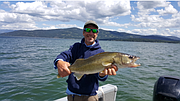Three anglers catch walleyes implanted with $1,000 tags
Three anglers catch walleyes implanted with $1,000 tags
Fish heads may be good for fertilizer, but at least two North Idaho anglers know they can also grow your bank account.
Mike Gordon of Sandpoint and Tony Butler of Hope added a grand to their pocketbooks after turning in the heads of walleye they caught in May in Lake Pend Oreille to Idaho Fish and Game.
As part of its incentive program to reduce the walleye population in Lake Pend Oreille, Fish and Game began planting tiny tags in the heads of 100 walleye.
When the fish are caught, anglers are urged to turn in the fish heads because they may contain the implanted tags and earn the fishers a thousand bucks.
Gordon caught his tagged walleye while fishing for bass near the Cabinet Gorge dam, more than 20 miles from where biologists tagged the walleye last year near Kootenai Point a couple miles east of Sandpoint.
“I told my father-in-law this is going to be the one,” Gordon said.
Butler’s winning walleye was tagged two years ago near Sagle and remained in the northern part of the lake where Butler caught it last month.
Another angler from Twin Falls who didn’t want to be identified also caught a thousand dollar fish last month in Lake Pend Oreille’s northern reaches. All the fish were around 20-inches long, according to Fish and Game.
The tiny tags are almost invisible, and the heads must be scanned by biologists to determine if they have tags.
Fish and Game spokesperson Kiira Siitari said the lake’s growing walleye population poses a threat to the lake’s ecosystem and its multi-million dollar recreational Kamloops rainbow trout, and kokanee fisheries.
“Biologists are concerned that if left unchecked, walleye numbers will continue to increase to the point of collapsing the keystone kokanee population,” Siitari said.
Kokanee are the food that the world-class rainbow trout rely on to grow.
Lake Pend Oreille walleyes — a predator that also feeds on kokanee — are thought to have washed downstream into Lake Pend Oreille from the Noxon Reservoir.
“Studies indicate Pend Oreille walleye feed primarily on kokanee in the deeper parts of the lake and yellow perch in the shallower areas,” Siitari said. “Their population has been growing exponentially since 2014.”
The state has done walleye surveys every three years since 2011, and will complete another survey this fall. There is no bag limit on walleyes in the Lake Pend Oreille system.
Chad Landrum, who runs a fishing charter business in Sandpoint, said the number of walleye has probably dropped substantially over the years because Fish and Game also targets the fish with gillnets.
Landrum said he caught 77 walleye in one day in June in 2014, but he has not caught the predatory newcomer in abundance since then.
“I caught eight so far this year,” Landrum said.
Landrum has petitioned Idaho Fish and Game to let anglers catch the fish instead of gillnetters and thinks Fish and Game’s concern that walleye will deplete the lake’s kokanee are unfounded because the fish stick mainly to the shallow northern lake, and not the deeper water that the lake is known for.
“Most of the lake is 200 feet deep, it will never be walleye habitat,” he said. “I always considered walleye a low-density fishery.”
Biologists also tag walleye with acoustic transmitters to track fish movements, which Idaho Fish and Game documents on its website. The fish maps help anglers catch walleye, Siitari said.
The data so far shows the Pend Oreille walleyes are very mobile, capable of moving more than 10 miles per day mostly during the late summer into the early fall.
Butler said despite trying, he hasn’t caught many walleye in the lake.
“We do target them, but it can be very hit or miss,” he said.
Landrum said the angler incentive program has anglers catching the fish instead of leaving them to the gill netters.
“At least they are letting us fish for them,” he said.
Fish and Game said 97 walleye with $1,000 tags are still finning around the lake for anglers to catch, because the three fish caught last month were the first $1,000 tag winners since the program launched a year ago.
And the fish taste just as good as ever.
“Everyone likes to eat walleye,” Landrum said.
Gordon said his thousand-dollar fish tasted, “Amazing.”





